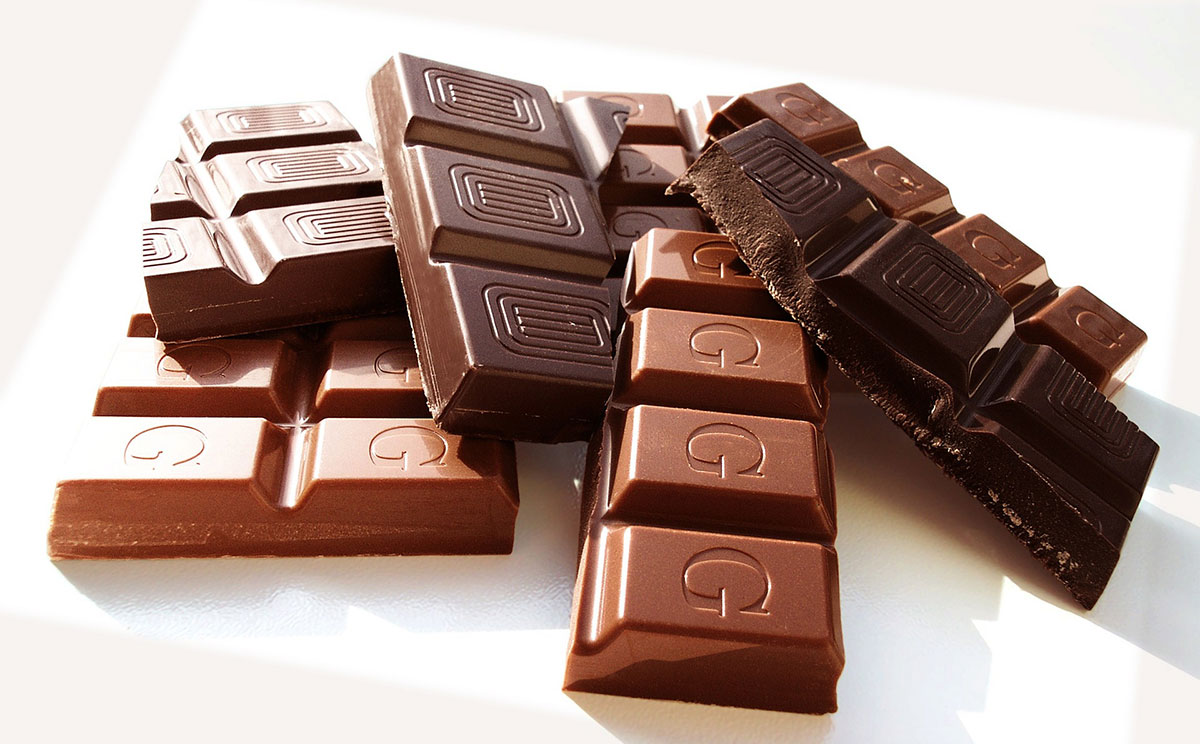 |
  
|
Chocolate MythsHere are many popular myths about chocolate. How many can you tell are true or not? Skeptoid Podcast #988  by Brian Dunning I want to welcome all of you today for coming here to Skeptoid, which you did because you know that May 15th is National Chocolate Chip Day, which is totally a real holiday and totally not made up by the chocolate companies. The day is in honor of Ruth Wakefield of Massachusetts, who in 1937, added chunks of Nestlé chocolate to a batch of cookies. In exchange for a lifetime supply of chocolate, she sold them the right to put her recipe on their packaging, which they named for the place she worked: The Toll House Inn. I'm going to start with a really quick brief on chocolate, as these basics impact quite a few of our myths. Chocolate comes from the seeds of the cacao tree. According to DNA studies, this tree originates around Ecuador and grows natively from southeastern Mexico to the Amazon basin. They were originally cultivated by humans in Peru and Ecuador, producing the modern Nacional cocoa bean, originally the dominant variety in the world, but today the market is dominated by various hybrids, which are all very similar. Mesoamerican cultures have been using the cacao tree as a food source for more than 5,000 years, and it was introduced to Europe as a beverage in the 16th century. The seeds are fermented, dried, roasted, and ground to form cocoa mass, which is the basic product that you can then do different things with to make various chocolate products. OK? Got it? Great. So now that chocolate invades every part of our lives (and rightfully so), we (being humans) have to ruin everything with conspiracy theories and false claims. So today, I present a roundup of some of those you're most likely to hear. Beginning with: Myth #1: Chocolate is high in caffeine.The caffeine comes from the brown cocoa solids in the cocoa bean, so the darker your chocolate the more caffeine it contains. White chocolate contains none. Compared to coffee, chocolate has much less. A standard Hershey's bar gives you 9 mg of caffeine; the average cup of brewed coffee gives you ten times that amount. Myth #2: Chocolate causes acne.We still don't have a very clear answer on this. Findings of studies have gone both ways, however all of these studies have been very small, so none of them can be considered definitive. What we can say is that genetics plays by far the largest role, as that's what determines the size of our skin's sebaceous glands. Regardless, your overall diet's total intake of sugar, fat, and dairy is always going to be more important than any one given food. Myth #3: Chocolate comes originally from Africa.While it's true that most chocolate comes from Africa today, it didn't come from there originally — as we discussed in the intro. In the 1800s, Portuguese merchants brought cacao trees from Brazil to Ghana, and plantations quickly spread to grow the valuable commodity as demand exploded in Europe. Today most chocolate comes from Ivory Coast and Ghana, where growing conditions — and labor and economic conditions (more on that soon) — were a perfect fit for the crop. Myth #4: You should only eat chocolate made from cacao, not from cocoa.This is really dumb. Cacao and cocoa are exactly the same thing. The tree is usually called the cacao tree, and the bean (which is the roasted seed of the cacao) is usually called the cocoa bean. But as we see every day, clever marketing people go "Aha! Cacao is a much more exotic and exclusive sounding word than cocoa; we're going to go with that on our packaging." So of course you're going to hear that cacao is better than cocoa. They're exactly the same thing. Myth #5: Most chocolate is unethically sourced.So the chocolate industry in Africa is far bigger than that in South America, so by default, all the major chocolate companies get their product from Africa. Child labor is a much bigger problem in Africa than it is in South America. But the major companies are those that face the most scrutiny, and employ supply chain auditing firms to ensure that their product is ethically sourced. Usually the biggest African suppliers have the fewest labor violations; but there are many more smaller producers than bigger ones. Bottom line is it's complicated and nearly impossible to enforce or even to investigate. I'm calling this one a "myth" because there is really no broad brush with which you can accurately paint an answer to this question. Myth #6: White chocolate isn't real chocolate.People can debate their own definitions all day long, but white chocolate is made from cocoa beans, so it's chocolate. Cocoa beans contain fat called cocoa butter, and this is what's used to make white chocolate. The brown cocoa solids are not used. In the United States, white chocolate can be called that so long as it's at least 20% cocoa butter and 14% milk solids. Myth #7: Chocolate will kill your dog.Chocolate actually can kill your dog, but I'm still classifying this as a myth because it takes a lot of chocolate before your dog's life is in danger. Deaths are rare. Chocolate contains caffeine and theobromine, both of which can cause arrhythmia, seizures, and hyperthermia. Symptoms to look out for include vomiting and tremors, plus other symptoms that are not so obvious. If your dog doesn't display those, he's probably just fine. Toxicity depends on the dose, which depends on the size of your dog and the amount and type of chocolate. Myth #8: Chocolate will give you cavities.Chocolate is high in sugar, so it contributes to cavities no more than any other food with that much sugar. However, sticky ingredients like nougat or caramel can get stuck in your teeth, giving them longer to feed the bacteria. Dark chocolate has less sugar, so is less harmful to teeth. Myth #9: Chocolate is fattening.Chocolate does contain a lot of sugar and fat, but they won't expand your waistline any more than they would if you ate them as part of some other food. Chocolate makes you fat in exactly the same way grapes and avocados do. Myth #10: Chocolate gives you energy.Definitely true. Chocolate is loaded with sugar, fat, caffeine, and theobromine, so it's a great snack before working out or playing sports. However, there's nothing special about chocolate that you wouldn't get from any other food containing those same nutrients. Myth #11: Chocolate is good for heart health.Don't turn to chocolate for heart health. Some people point out that darker chocolates are high in a flavonoid called flavanols that are associated with a lower risk of heart disease. However, it's not enough to have any noticeable health effect, even if you ate massive amounts of chocolate. Myth #12: Chocolate has no nutritional value.Everything in chocolate has nutritional value. You need sugar, you need fat. Chocolate also has lots of essential minerals. We can't say it often enough: every food can be part of a healthy diet, or of an unhealthy diet. The only thing that matters is that your diet generally doesn't overindulge in too much of anything. Myth #13: Chocolate raises your cholesterol.Just eating more chocolate is unlikely to have any effect on your cholesterol. But what we've found is that replacing about 270 of your discretionary daily calories a day with a combination of almonds, dark chocolate, and cocoa powder resulted in a significant reduction in LDL (the "bad" cholesterol). By themselves, only almonds had a similar effect. So again: Don't turn to chocolate for heart health. Myth #14: Chocolate is addictive.It kind of is, actually. Studies have found that specific foods, including chocolate, can trigger the brain's reward system, causing compulsive urges. The Yale Food Addiction Scale has found that chocolate is second only to pizza in being rated as most problematic by people with food addictions. Also ranking up there? Ice cream, french fries, and chips. Myth #15: Diabetics can't eat chocolate.Yes they can, but like with all foods, diabetics need to pay closer attention to how much and how often they eat chocolate. Simply eat it in moderation, and not too often. Avoid white chocolate, and stick to darker when you do eat it: darker chocolate with a higher cocoa content (say 70% or more) may improve insulin sensitivity. Myth #16: White chocolate is healthier than milk chocolate.This is definitely not true. White chocolate is basically just chocolate without the good stuff: those cocoa solids are where all the flavanols and antioxidants are. White chocolate is just a lot of fat and sugar. Now, fat and sugar are indeed nutrients, so if you eat it as part of your normal daily intake of those things, it's a perfectly fine part of your diet. Myth #17: Dark chocolate is healthier than milk chocolate.Not really. Yes, dark chocolate has more of those flavanols and antioxidants, just not enough to make any meaningful difference. Milk chocolate, on the other hand, has more milk solids containing calcium, protein, vitamins, potassium, and more — but also not enough to make any meaningful difference. Look, no chocolate is a magical superfood. Pick the kind you like the best, and enjoy it in moderation. Myth #18: There's no chocolate Brian won't eat.It turns out this myth is false. There is indeed a chocolate Brian won't eat. When I was a kid someone gave us these gold foil wrapped chocolate coins, probably for Easter. I don't know if they were mostly just wax, or if they'd gone bad, or were just incredibly cheaply made — but to this day I can't stand the thought of eating chocolate coins that come in foil wrappers. They were disgusting. Call me crazy — I can still taste them. So now you know all there is to know about chocolate myths. Some are true, some are false, but most aren't enough so that it makes any real difference. Enjoy your chocolate, don't eat too much of it like I do, and be sure to do what I say and not what I do.
Cite this article:
©2025 Skeptoid Media, Inc. All Rights Reserved. |